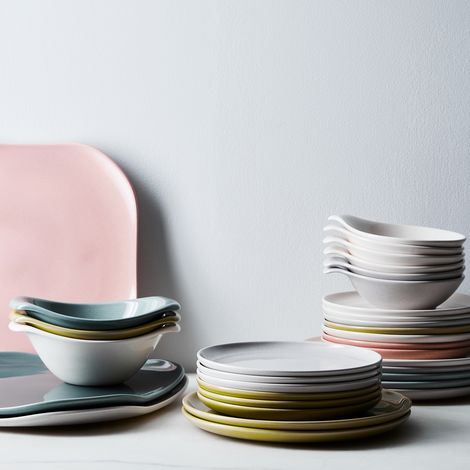Interior Design
Meet the Man Behind the Best-Selling American Dinnerware Line of All Time
When most Americans think of a successful lifestyle brand, the first name that may come to mind is Martha Stewart. When Martha Stewart thinks of a successful lifestyle brand, the first name that comes to mind is Russel Wright. Wright was “the first American lifestyle designer of the 20th century,” she says. “How we live today has a lot to do with Russel and Mary Wright.”
Born in Ohio in 1904 and educated briefly at Princeton where he studied architecture, Russel Wright got his start designing sets for theater under Norman Bel Geddes (the man behind Futurama), the famous General Motors Pavilion at the 1939 New York World's Fair). Russel’s wife Mary, a designer herself, encouraged him to reconsider some of his props as home decor pieces. He began creating bookends and barware, and went on to design flatware, furniture, textiles, and, most famously, his "American Modern" ceramic dinnerware, which is the best-selling line of American ceramic dinnerware of all time. In the process, he became one of the models for the “Good Design” movement of the mid-20th century, and changed the way Americans think of the everyday objects in their homes.
“I believe with religious intensity that good design is for everyone,” Wright famously said, and it was this ethos that inspired his work. His pieces are emblematic of “Good Design”: their smooth lines, muted colors, and sturdiness embody “functionalism, simplicity, and truth to materials,” the quintessential qualities of “Good Design,” according to the Museum of Modern Art.
With a focus on the table as the center of family living, Wright rejected earlier American design styles for being too formal and not useful enough for the day-to-day needs of the modern homemaker. He made use of new technologies that allowed him to design mass-manufactured pieces explicitly priced to be affordable for the middle-class; to that end, he worked with spun aluminum in place of chrome, and earthenware in place of porcelain.
His designs were meant for daily use; in the late 1940s, Russel and Mary famously demonstrated the durability of the dishwasher-safe line of dishes by tossing the dinnerware on metal tables and hard floors. Above all, he considered the growing population of suburban families in America, and worked to create objects that fit into their lives—not the other way around.
His work found its greatest success—both commercially and in terms of fully embodying his ideal of “Good Design”—in his “American Modern” ceramic dinnerware, which to this day is the best-selling dinnerware line of all time (between 1939 and 1959, 250 million pieces were sold in the U.S.) and his “Residential” melamine dinnerware, which became the best-selling line of melamine dinnerware in the country. Much of this success is credited to his wife Mary, who is considered to be a marketing genius. Mary promoted Russel’s products not simply as dinnerware or furniture, but as a lifestyle.
They sold the dinnerware (featuring the first rimless plates and bowls and Russel’s trademarked signature on the bottom) in a low-priced starter set of 12 pieces, which allowed consumers to add to their collections over time, as their budgets allowed. They showcased the work in print advertising, on the radio, and at department stores, where they set up showrooms featuring tables set with the full line of products to communicate the way the pieces could live together in the new modern American home—a radical approach to merchandising at the time.
Russel Wright American Modern Dinnerware
More Options
Shop Russel Wright American Modern Dinnerware Now
Together, they reimagined life for middle-class Americans, sharing a dream for “a unique American lifestyle that was gracious yet contemporary and informal,” according to design curator Donald Albrecht. They pictured homes that were open and airy, dinners that could be brought from the oven to the table, and meals where guests could feed themselves from a buffet—all brand-new ideas for mid-century homemakers, and concepts that have become today’s norm.
In 1950, Russel and Mary published a book, Guide to Easier Living, which laid out their vision for simplified modern living, from open floor plans to casual entertaining. “A home carefully planned around the requirements of your own family will provide much richer satisfactions. Imitation of other people’s ways holds pale pleasure at best beside that of creating one’s own,” they wrote. “We look forward to the day when living room, dining room and kitchen will break through the walls that arbitrarily divide them, and become simply friendly areas of one large, gracious and beautiful room.”
Even Martha can’t disagree with that. “I’m constantly thinking this way,” she says, “and yet here it was, already written for me.”
Mary Wright died in 1952 and Russel in 1976. But their legacy lives on—not only in their plates and bowls, but in the way we live today.
The Wrights weren’t alone in their vision for a modern American lifestyle. To get you better acquainted with mid-century modern design, here are nine more American modern designers you should know.
Charles and Ray Eames
Best known for their bent plywood, fiberglass, and plastic furniture, and their use of bright colors, husband and wife team Charles and Ray Eames designed pieces intended to fit humans and their lives, from chairs that mimic the curve of a spine to modular storage units that could be easily adjusted.
If you like these designs you might like:
George Nakashima
Often referred to as the father of the American craft movement, MIT-trained architect George Nakashima is most famous for his large-scale wood tables, which feature smooth-topped surfaces, butterfly joints, and natural, unfinished edges, as well as his chairs, which embody his “Japanese Shaker” aesthetic.
If you like these designs you might like:
George Nelson
As the director of the Herman Miller furniture company, George Nelson is credited as one of the founders the American Modernist design movement, introducing such concepts as the family room and the storage unit to the American home, and the cubicle to the American office. After his death, it was revealed he took credit for many designs that were not originally his own, including the famous Marshmallow Sofa, which was in fact designed by Irving Harper, who worked for Nelson at the time.
If you like these designs you might like:
Florence Knoll
A trained architect, Florence Knoll changed the design business when she convinced her soon-to-be-husband Hans Knoll to work with architects on designing furniture for his interior design business. After Hans’ death in 1955, Florence took over the business, and she and a cohort of architects and designers—including Ludwig Mies van der Rohe, Anni Albers, Marcel Breuer, Eero Saarinen, Isamu Noguchi, and George Nakashima—created some of the most iconic home and office furniture of the mid-century modern era. She is still alive at 101 years old.
Harry Bertoia
Italian-born American designer Harry Bertoia is best known for his Diamond Chair, which he created for Knoll in 1952. Highly structural, the wide metal lattice is both durable and delicate, and his chairs introduced wire mesh as a viable material for mid-century modern designers.
If you like these designs you might like:
Milo Baughman
Working with classic mid-century modern materials like stainless steel, glass, chrome, and leather, Milo Baughman helped to create the California Modern aesthetic, which integrated organic elements into mass-produced designs. “I thought Modern design would change the world,” Baughman said. “Now, I no longer have such lofty hopes, but perhaps the world is just a bit better off because of it. In any event, good Modern has already proven to be the most enduring, timeless and classic of all design movements.”
If you like these designs you might like:
Copper and Brass Louise Vases
$25–$195
More Options
Shop Copper and Brass Louise Vases Now
Paul Evans
Working in the Brutalist style, Paul Evans’ imposing furniture is crafted from metals and wood, and have strong geometric designs. Unlike Russel Wright, Evans favored hard edges, sharp lines, and physically heavy furniture design.
If you like these designs you might like:
Eero Saarinen
Finnish-American Eero Saarinen is responsible for some of the most widely recognized work of the mid-century modern design movement. Not only is he famous for the sleek curved lines of his Pedestal Table, Tulip Chair, and Womb Chair, but he also designed such iconic buildings as the TWA terminal at JFK Airport in New York, Dulles Airport in Virginia, and the Gateway Arch in St. Louis.
Are you a fan of mid-century modern design? Let us know in the comments!













































See what other Food52 readers are saying.